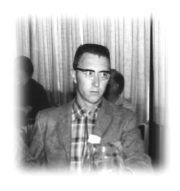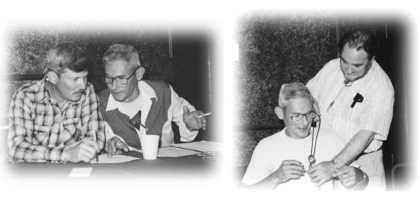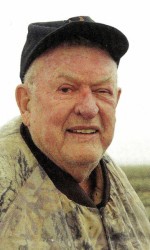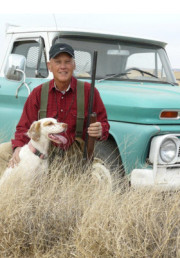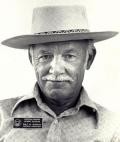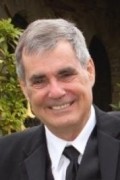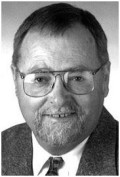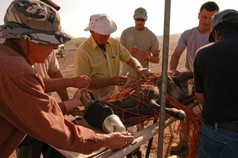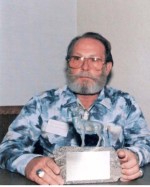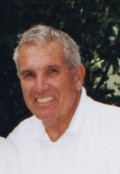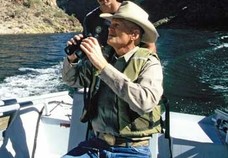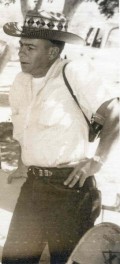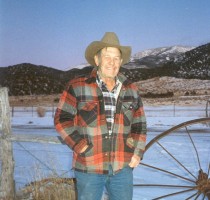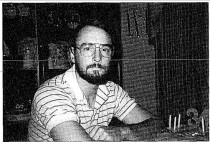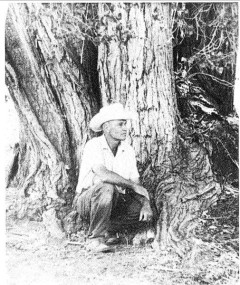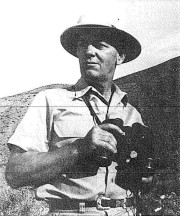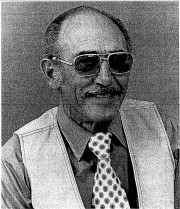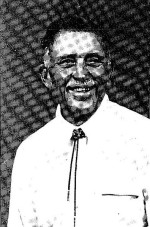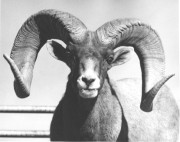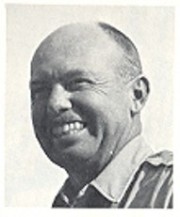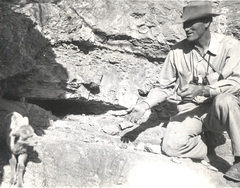
In Memoriam
Lives are precious things, and what we choose to spend them on speaks to our values and the things we most hold dear. In our lives, we are fortunate to encounter special people that make a difference professionally and personally. There have been several special people that made a difference in bighorn sheep management that have ended their mortal careers and the Desert Bighorn Council commemorates their memories.
Pete Sanchez passed away last fall (2014) in Glenwood Springs, New Mexico. Pete was a long time Park Naturalist in Death Valley. Pete was the Secretary/Treasurer of the DBC in the early 1980's (while he was simultaneously the Secretary/Treasurer for the Desert Pupfish Council). He was responsible for bringing the feral burro population of Death Valley National Monument to ZERO, with help from one of the early BLM burro gather contractors. Pete did some experimental work with Saltcedar at Death Valley, and determined that a medium sized Saltcedar (not the Athol variety) could pump as much as 250 gallons per day from the ground surface. This figure is used today to justify guzzler construction in northern Nevada, as Saltcedar invaded many dry washes there in the 1970’s.
Contributed by Ray Lee with help from Don Armentrout
James Donovan Yoakum (1926-2012)
Most of you reading this probably do not know who Jim Yoakum was, but read on. He was born in Templeton, California on June 14, 1926. He served in the U.S. Navy from 1944-1947, seeing many tough battles, including Iwo Jima. His time in service was a small part of his life, but the G.I. Bill gave him an education, a career, and a place to call home. After seeing the devastation of war, he sought wilderness and wildlife. His first purchase after WW II was a saddle, while taking a job as a forest lookout near Big Sur, on the California coast. After that summer he attended Humboldt State College in the redwoods of California, graduating in 1953. He went on to Oregon State University, where he earned a Masters, in 1957. Jim was hired by the Bureau of Land Management as its first wildlife biologist and spent most of his 28-year career in the BLM Nevada State Office in Reno. He did take time out to study alpacas and vicunas in South America in the mid 1960’s, and did a stint or two at teaching at both Humboldt State and University of Nevada Reno. Jim was a very strong advocate for wildlife and for professionalism among wildlife biologists. He was a mainstay in the Nevada chapter of The Wildlife Society as well as the Western Section of TWS, where he held several positions and was honored with several awards. Jim continually pushed biologists around him to do better for wildlife and wildlife management.
He earned his MS on Pronghorn from OSU studying pronghorns. Those speedsters were the wildlife love of his life. He co-authored “Pronghorn Ecology and Management” with Bart O’Gara, a comprehensive 900+ page book to which he made last-minute changes up until the very time it went to the printer. The book represents a monumental bookend to his love of wildlife and wild places, and a solid foundation for those who follow.
While earning his Master’s, Jim used a black Labrador retriever to help him locate antelope fawns. The dog would hold the fawns down with his paws until Jim got to them. He had a succession of Labs, mostly black (the second to the last one last one, Teena, was a yellow Lab), throughout the rest of his life, and they accompanied him anywhere he drove. It should be noted that “Teena” is an American Indian name for pronghorn.
Along the way, Jim also found time for desert bighorn sheep. He attended many DBC annual meetings in the 1960’s and into the early 1970’s. Jim served one year as a member of the DBC Technical Staff, and presented several papers, but is most remembered for being DBC Transactions editor from 1965 through 1971.
For those of you who attended the 50th year of the Council in Las Vegas in 2007, Jim was there, older and slower but still the hard-core wildlife advocate he always was.
He passed over on November 20, 2012.
By Rick Brigham, with help from Don Armentrout and Dick Weaver
In Memory of Gale Monson
August 1, 1912-February 19, 2012
Prepared by Esther Rubin, DBC Secretary
When I started studying bighorn sheep, the book “The Desert Bighorn” served as an invaluable resource on these incredible animals. Today, my copy of this book is well-worn, with notes and dog-eared pages throughout. Many of you may also have relied on this book, which is still one of the most complete sources of information on desert bighorn sheep. I never had the opportunity to meet Gale Monson, but the names “Monson and Sumner” will always stick in my mind as editors of this well-used book. Gale Monson passed away at the age of 99 this past February, after a lifetime committed to the study of the natural world–birds, bighorn sheep, and beyond. The following obituary was presented in The Arizona Daily Star (http://www.legacy.com/obituaries/tucson/obituary.aspx?n=gale-wendell-monson&pid=156261232). An amazing career and life-long dedication to the natural world.
~~~~~~~~~~~~
Naturalist and Author Gale W. Monson, born August 1, 1912, passed away peacefully at his Albuquerque home on February 19, 2012. He was preceded in death by his beloved wife of54 years, Sally. He is survived by his five children: Rosemary Remacle (Sunnyvale,CA); Margaret Monson (Seattle,WA); Fred Monson (Lehigh Acres, FL) and his Albuquerque daughters, Anne Monson and Ruth Bear and their respective husbands, J.G. Alaimo and David Bear. He is also survived by eight grandchildren and seven great-grandchildren. Born in Munich, North Dakota, Gale studied the natural world throughout his life, from his early years on his parents' farm and through almost a century of living, this was his passion. He spent his professional life working for the U.S. Bureau of Indian Affairs, the Soil Conservation Service and the U.S. Fish and Wildlife Service. His work assignments took him and his family o Albuquerque, Gallup and Socorro, New Mexico; Parker, Yuma, and Tucson, Arizona and Washington D.C. As part of the "greatest generation," he served in the U.S. Army medical service corps in the Burma-India theater during WWII. Gale loved the Sonoran Desert and spent the bulk of his life's work there, where he contributed greatly to its study. His greatest passion was ornithology, but he had an abiding love for the study of the natural world in its entirety. He moved to Arizona in 1934 where he worked until 1940 as a biologist on Papago (now Tohono O'Odham) and Navajo tribal lands, as well as for the Soil Conservation Service in Arizona and New Mexico. In 1940 until 1969, except for time spent in the Army during WWII, he worked for the U.S. Fish and Wildlife Service at refuges in New Mexico and Havasu and Imperial National Wildlife Refuges on the Colorado River, and on the Kofa and Cabeza Prieta Game Ranges in Arizona. From 1971-1977, Gale served the Arizona-Sonora Desert Museum as the supervisor in charge of weekends, holidays and as acting director in the absence of the director. He is best known as one of the authors of The Birds of Arizona, as well as The Desert Bighorn, The Birds of Sonora, and The Annotated Checklist of Arizona Birds. Gale also authored and edited numerous other publications during his career. He was a prolific writer and record keeper; Southwestern ornithologists continue to refer to his extensive written records of bird sightings. Gale influenced numerous people throughout his life and will live on in the hearts and memories of his family and many friends. A Memorial Service will be held in Tucson on Sunday, March 18, 2012 please contact a family member for details. Contributions in his memory can be made to the Gale Monson Research Grant fund of the Arizona Field Ornithologists at www.azfo.org/grants.html.
Dr. Clarence “Clancy” Gansberg
January 24, 1923-December 5, 2011
Wildlife professionals, by definition, are paid to travel to/from and to participate in field projects. Many of these projects are difficult; some even dangerous. A group that often makes these projects possible, frequently adding skills and talents not generally possessed by wildlife professionals is comprised of volunteers. These people donate not only their time and talents, but they also pay their own way to participate in these projects. These volunteers are truly dedicated to wildlife conservation.
We recently lost one of the most dedicated of these volunteers. Dr. Clarence “Clancy” Gansberg, DVM, died at home in Yuma, Arizona, December 5, 2011, at the age of 88.
Clancy was born January 24, 1923, in Webster, South Dakota, and grew up in Stanwood, Washington. He worked as a sheet metal fitter in the ship yards before joining the Army Air Corpsduring WWII. As a First Lieutenant, he flew the Boeing B29 Super fortress. He survived 30 missions over Japan; and was awarded the Distinguished Flying Cross, the Air Medal with four Oak Leaf Clusters, six Asiatic-Pacific ribbons, and the Presidential Unit Citation.
After the war,he studied to become a Doctor of Veterinary Medicine at Washington State University. He then moved to Klamath Falls, Oregon, where he lived and practiced for 30 years. He, and his first wife Marjorie Petty, raised 3 boys- James, Ronald, and Jeffrey. Clancy was an avid hunter and fisherman; and was active in several service organizations.
After retiring in 1981, he traveled in the summer and wintered in Yuma, Arizona. After learning of a WWII B17 bomber that had crashed into the Gila Mountains during training, he climbed to the crash site many times, and spearheaded an effort to construct a monument to the crew. In Yuma, he met his second wife Loree Wirt, and continued his associations with service organizations.
Annually he volunteered with the Arizona Game and Fish Department as a veterinarian during captures of desert bighorn sheep and Sonoran pronghorn. Clancy first showed up at some of our bighorn sheep capture sites near Yuma in the mid-1980s; eventually showing up at nearly every wildlife capture the Arizona Game and Fish Department did.
The level of care at our wildlife captures changed significantly after Clancy showed up- they went from rather amateurish efforts to carefully orchestrated mobile hospitals- with the mortality rates during captures plunging. During the 20 year period from 1985-2005, he handled 748 bighorn sheep during translocations. During these events he had the opportunity to pioneer some new techniques. One of these was published in the Desert Bighorn Council Transactions, “Survival of bighorn sheep following surgical amputation of fractured limbs”co- authored with his long time partner and fellow veterinarian Bob Kreycik. Clancy even sewed up the kneecap (with no anesthetic) of one of our net gunners, who had accidentally shot himself in the knee.
Dr. Gansberg’s family has asked that memoriam donations be sent to the Shriners Children’s Hospital and the Desert Bighorn Council’s Hansen-Welles Scholarship Fund.
Submitted by Ray Lee, DBC Tech Staff Chair
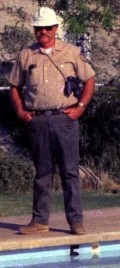 While preparing for the 1976 Santa Rosa Mountains Waterhole Count, Bonnar posed near a swimming pool that is occasionally used as a water source by bighorn sheep in Rancho Mirage, Riverside County, California.
While preparing for the 1976 Santa Rosa Mountains Waterhole Count, Bonnar posed near a swimming pool that is occasionally used as a water source by bighorn sheep in Rancho Mirage, Riverside County, California.
He enjoyed a wide array of experiences and held multiple professions during his lifetime; a cowboy in his youth, bank loan officer, gold miner in Costa Rica, assistant and associate professor in Oklahoma and Texas, outfitter and guide in Colorado, self employed environmental consultant, and wildlife research biologist in Arizona. His formal education started at the University of Arizona where he earned his B.S. in range management, followed by an M.S. in wildlife management from Colorado State University. At Virginia Polytechnic Institute, Ted obtained his PhD in wildlife ecology and then a post–doctoral fellowship at the National Institutes of Health, Albert Einstein Medical Center in Philadelphia, Pennsylvania.
The depth and breadth of Ted’s contribution to wildlife science is remarkable. He is widely published in topics ranging from the ecology of the flannelmouth sucker and rainbow trout in the Colorado River, and dietary overlap in meso-carnivore populations to identifying trans-highway movement corridors for desert bighorn sheep and the ecology of mountain lions. Perhaps his greatest contribution to the conservation of bovids is the monograph he authored entitled “Evaluation of factors potentially influencing a desert bighorn sheep population”. At the time of his passing, Ted was embarking on an ambitious study to determine the effect of mountain lion predation on stable, increasing, and decreasing desert bighorn sheep populations.
Our challenge is to gain the intuition of Ted’s unique perspective, earned through a lifetime of awareness and perseverance, and to continue where he left us.
Be at peace, Ted.
Florence "Buddy" Welles
August 21, 1907 - January 23, 2004
Most of us knew her as “Buddy”, the first Ewe of the Desert Bighorn Council. In the drawing I made for the title page of the Desert Bighorn book, Buddy is the
only ewe, centered, as she was the only female bighorn researcher in the early years. The rams arranged along the skyline represented the male contributors to the book. The drawing was never used in
the final printing and I had it framed as a gift to Gale Monson, who along with Lowell Sumner, edited the final draft of the book.
Buddy and I were wives and partners of sheep biologist and first became friends in 1960. Chuck and I with our two children were stationed at Corn Creek Field Station, part of the Desert National
Wildlife Refuge. Ralph and Buddy were deep into their research of the Desert Bighorn of Death Valley. Ralph's 17 year career with the National Park Service encompassed their studying and
photographing the elusive Desert Bighorn. In 1961 the National Park Service published 'The Bighorn of Death Valley', the first life-history study of these sheep.
Buddy and Ralph were original members of the Desert Bighorn Council, actively involved in all its activities. Ralph was awarded the first Desert Bighorn Council Award. I currently have this award and
will return it to the council at the 2005 meeting in Texas.
When Chuck was killed in 1973 while on an aerial survey to locate a site to transplant bighorn to ranges in Utah, a memorial fund was set up to aid young biologist who shared an interest in the
survival and study of the sheep. Later, when Ralph passed away we renamed the fund the Hansen-Welles Memorial Scholarship.
About ten ears ago Buddy sold one of their valuable original oil paintings and used the money to produce a video of the Bighorn of Death Valley. It might be fun to play it at the next Council meeting
in their honor.
I spend long weekends with Buddy just before she passed away and her memory of their field days studying the Death Valley Sheep was remarkable. In Ralph's early days as a teenage cowboy he learned to
name the various cattle in the herds and gave them distinctive names. This he did with the sheep and they individually identified many of them with special names.
Buddy's stories of their adventures were vivid. One in particular was special. At one of the springs in the mountains of Death Valley she got into the water and sat with only her head (with hat)
above the surface. After several hours her patience was rewarded when sheep came in to drink right in front of her.
Buddy was a special helpmate in their 61 years of marriage. She was with Ralph during all his research, carrying cameras, taking notes, and finally typing the drafts of 'The Bighorn of Death Valley'
on a tiny portable typewriter in their small camping trailer. This doesn't count the usual camp chores.
In her 96 years she successfully mastered four separate goals. First, receptionist for the Actors Equity Association, a precursor of today's Screen Actors Guild. Second, 18 years at the Palo Alto
Community Theatre, where she acted, danced, designed and directed choreography for the shows and played the accompaniment of their many musical productions. Third, her 17 years with the National Park
Service, and fourth, 31 years as a volunteer in a Hospital Auxiliary.
Throughout all her years she continued her musical career. I shall never forget awakening to special music when visiting, for she played her special 105 year old Steinway regularly till the end of
her life. Most of what she worked at during her lifetime was done on a volunteer basis. A wonderful woman! I am proud to call her one of my best friends.
-- Pat Hansen, May 2004
Terri Lynn Steel
1963-1988
Terri Lynn Steel was born in Bisbee, Arizona 18 July 1963. She died 28 May 1988. She lived in Arizona until her family moved to Virginia in 1965, Starkville, Mississippi in 1975, and Seattle, Washington in 1978. In her heart she remained a "desert rat" all of her life.
As a child of 10, she visited us in the Chihuahuan Desert and began inquiring with young enthusiasm about desert animals. Over the years her questions sharpened and the excitement or learning about nature could clearly be seen in her eyes.
Terri loved to learn. In 1981, she graduated from Samanish High School in Bellevue, Washington and entered Washington State University (WSU). During the summers of 1981-85, she returned to the desert in Arizona and worked as a wildlife technician and research assistant at the University of Arizona. During these years her professional goals were established. She wanted a career in wildlife research
and began pursuing it in her junior year. Tern went out or her way to meet as many wildlife professionals as she could. As an undergraduate, she attended the North American Wildlife and Natural Resource Conference
several times to meet resource biologists and administrators and learn from them. It gave us joy to watch Tem grow professionally. She was on a track to success.
Terri entered graduate school in 1986 at Utah State University. Her MS. thesis involved habitat relationships of desert bighorn sheep at Capital Reef National Park. She presented the results of some of her
work at the 1988 Desert Bighorn Council Transactions in Needles, California. Her excellent presentation resulted in an offer to study for her Ph.D. at the University of Alaska. She was excited and planned to
complete her M.S. degree and move to Alaska in early 1989.
During April and May 1988, Terri had started her last field season in Capital Reef National Park. She had completed class work and needed only to complete final data collection. She did not feel well the last week of May, and upon her return to Logan mentioned to friends and to her mother on 26 May that she could not remember when she had felt so poorly. On 27 May 1988, Terri suffered a spontaneous rupture of a cerebral aneurysm at her home; she died the next day.
Tem was a loving person and, as fit her so well, her last gift was of life. She donated her organs so others could have the opportunity for a better life. Those of us fortunate to share a part of Terri's brief life know she made an impact. Her desire to learn and question "established fact" was contagious. Although she died too early, she made an impact on those who knew her. Terri's assistance is acknowledged in over 10
scientific publications and she will he an author on several works published posthumously.
Terri was active professionally and it is a pleasure to point to her accomplishments. She became president of the student chapter of The Wildlife Society at WSU 1985-86, and was selected the outstanding
senior student by the wildlife faculty. Additionally, she was chosen by the Washington State Sportsman's Council to receive the Lee Hughes Memorial Scholarship in 1986. Tem organized and hosted a Wildlife
Society radio show at WSU and was the coordinator for Initiative 90, a Funding initiative for the state of Washington. She was a member of The Wildlife Society and The Desert Bighorn Council. Terri's philosophy,
and the way she led her life, is embodied in the aphorism "Treat the earth gently." She dedicated her life to that cause. Her death has created a void in our lives.
Tem Lynn Steel is survived by her mother Marilyn Turner, stepfather Louie Turner, sisters Robin and Danna, brother Brian, father Phil Steel, other family and many, many friends.
A "Tem L. Steel" Scholarship has been established in the Department of Fisheries and Wildlife at Utah State University. Those wishing to contribute may send check or money order to: The Terri L. Steel Scholarship, Department of Fisheries & Wildlife, Utah State University, Logan, UT 84322-5210.
--Paul R. Krausman and John Bissonette
Reprinted with permission from The Wildlife Society.
Ralph Emerson Welles
1903-1988
Ralph Emerson Welles was born on 25 November 1903 in Oklahoma. He was an actor in Hollywood in the early days of talking pictures and played in films with John Wayne, Edward G. Robinson, Greta Garbo, and others. In 1932, Ralph left Hollywood to become director or the new Civic Theater in Palo Alto, California. Ralph directed and wrote plays and musical shows at the Civic Theater until 1950. He also taught in the Speech and Drama Department at Stanford University during this period.
From Hollywood, Ralph entered the National Park Service as a ranger-naturalist, wildlife researcher, and photographer. With his wire Florence (Buddy), he conducted the first life history study of native desert bighorn sheep in the southwest resulting in the National Park Service Publication "The Bighorn of Death Valley." Ralph and Buddy regularly endured incredible heat in Death Valley to capture details of bighorn sheep activity. Ralph's dedication to truth in reporting scientific observations was absolute. Where no facts were as yet available he always carefully labeled educated speculation as such. Ralph Welles was an alert observer and a founding member of the Desert Bighorn Council. He was always concerned about the wise use and management of bighorn sheep. In 1967, Ralph left the National Park Service and moved to the California coast.
Since his arrival on the California coast, Ralph was a supporter of art and music, the Arroyo Grande Community Hospital Auxiliary, and Five Cities C.A.S.T. On Friday, 8 January 1988, Ralph E. Welles died.
He is survived by his wife of 61 years, sisters Betty Howell and Phyllis Grant, and brother Rolin Eslinger, and numerous nieces and nephews. At the request of his wife, friends may donate money in his name to the San Luis Obispo Art Association, the Symphony Guild, the Mozart Festival, and the Arroyo Grande Community Hospital Auxiliary Fund for the in-home Emergency Response System, or a charity of their choice.
--Lowell Sumner, Glenwood, New Mexico
A tribute to William Cooper, Charles Hansen, John Ebersole, and Dick Smith
Let us not remember William Cooper, Charles Hansen, John Ebersole, and Dick Smith in terms of what they died for; but rather the reasons for which they lived. These were men dedicated to life--to LIVING THINGS.
They took life head-on--on its cutting edge--where one can stand closer to its naked beauty, raw meaning, and, at times in harm’s way.
Certainly they knew the risks their pursuits could involve, but they were willing t o face them, because they lived for some intangible something that many have ceased to fed, let alone try to understand.
In our destructive, maddening and over-quantified existences, some might even raise their eyebrows and ask, "Was it worth the price?" To them, the answer may never be apparent; but to others, it always has been.
A party of river runners slips quietly along the Colorado River near Sheep Bottom, below the crash site where they perished. One member glimpses movement in the ledges above.
"Bighorns!" The whisper sweeps the raft and the passengers gaze in awe at a living creature which--like so many others--has nearly slipped from existence.
Ask that passenger what he felt when he stared at wildness and was moved by that intangible something.
It is for instruments of life then--like Bill, Chuck, John and Dick--who would stem destruction and prevent our impoverishment, that we now remember and re-examine our own reasons for living.
Thomas L. Haxtman
Assistant Superintendent
Canyonlands National Park
Moab, Utah 84532
Award and Remembrance for our Friend Chuck
Dr. Charles ("Chuck") Hansen was killed in an airplane crash along with John Ebersole, William Cooper and Dick Smith, on May 19, 1973, while conducting a desert bighorn survey in Canyonlands National Park. The U.S. Department of the Interior’s "CITATION FOR DISTINGUISHED SERVICE", and a "REMEMBRANCE FOR CHUCK" are presented.
CITATION
FOR DISTINGUISHED SERVICE
CHARLES G. HANSEN
posthumously, in recognition of outstanding contributions to research and management programs on the desert bighorn sheep of the Bureau of Sport Fisheries and Wildlife and the National Park Service.
Dr. Hansen, an international authority on the desert bighorn sheep, began his career with the Bureau of Sport Fisheries and Wildlife in 1957. At the Desert National Wildlife Range, in 1959, he started his life-long studies of the rare desert bighorn. He was promoted to a National Park Service research position in 1968 and continued his investigations in Death Valley National Monument, and initiated significant research on the competition between the exotic burro and the native bighorn. A keen observer, an untiring field man, and a highly competent scientist, he made lasting contributions to the meager sum of existing knowledge about the species. He was the major author of the book, Desert Bighorn. Soon to be published, this volume w i l l be the first definitive book on the bighorn. H i s detailed reports, scientific papers, and professional publications provide the basis for modern bighorn sheep management. Other Federal and state agencies, conservation and sportsmen's groups, as well as agencies in Canada and Mexico, benefited from his services and advice on bighorn programs. To coordinate a united effort of research and management to restore and perpetuate this species, he helped establish the Desert Bighorn Council and became an active key member. In recognition of his professional achievements, the Council awarded him its International Award of Honor for 1966. On May 19, 1973, he was killed in the crash of a small plane while he was conducting an aerial survey of bighorn in Canyonlands National Park. As a tribute to his distinctive achievements, the Department of the Interior grants, posthumously, to Dr. Hansen its highest honor, the Distinguished Service Award.
(signed) Rogers C. B. Morton
Secretary of the Interior
A REMEMBRANCE FOR OUR FRIEND CHUCK
Dr. Charles G. Hansen, "Chuck" to all of us who knew him, was not a big man in size, but he was most certainly a giant of a man in stature. Chuck was best known through his work and love for the desert bighorn sheep. He was considered by his peers to be the world's foremost expert on desert bighorn. This statement is attributed to the work he has been requested to do by numerous State and Federal agencies in the United States, Mexico and Canada. His research and publications are known throughout the world. If someone were to say desert bighorn, the name Chuck Hansen comes to mind, as the two are synonymous. Dr. Charles Hansen is a household word in the profession of wildlife biology and ecology for the name carries with it mitigating respect.
You did not have to meet Chuck for only a few minutes before you were aware of his burning desire to do all in his power for the desert bighorn, as well as the other wildlife flora and fauna in the desert mountains of the Southwest. Chuck knew--to save the desert bighorn, would also result in the desert mountain ranges maintaining their natural state for all generations to see and enjoy, and to remain as something for which this country could always be proud. He strived to achieve this goal through sweat, tears, and even blood. He wrote, spoke, and fought for t h i s goal in his sincere and honest manner. In this effort lies the dignity and respect of all who knew him.
Chuck was one of the original members of the Desert Bighorn Council which began in the early 1950's. Since that time, the Desert Bighorn Council has grown to be one of the most respected, nationally known organizations in the United States. Chuck Hansen can take unlimited pride in this achievement, as he always has been one of the greatest motivating forces in the organization.
In the Desert Bighorn Council, a title of respect is to be called a sheep herder. Therefore, we fellow sheepherders want Chuck's immediate family to know t h a t the sweat, the tears, the triumphs and the heartbreaks have not been in vain. The endless tracks that Chuck has left across this land can never be filled. We, and all future sheepherders, can only strive to follow the trail he has left us. We do not say goodbye to Chuck, rather, we look forward to seeing him again in the Greatest of All Bighorn Councils.
With love,
The Desert Bighorn Council
(Reprinted from the 1974 DBC Transactions)
Robert D. “Jake” Metherell
January 23, 1928-February 7, 1973
Robert D. "Jake" Metherell died on February 7, 1973, when the private plane he was piloting crashed in the Ruby Valley south of Wells, Nevada.
Jake was born January 23, 1928, in Williamsport, Pennsylvania. He attended Lycoming College in Williamsport and received a B.S. degree in biology i n 1955. He married Connie Heim in 1951 and they had three children - Kenneth, Michael, and Kathy.
Jake began his career with the National Park Service i n 1956 as a seasonal ranger a t Acadia National Park, Maine. He held increasingly responsible positions at Blue Ridge Parkway, North Carolina, 1957-58; Acadia National Park, 1958-61; Yosemite National Park, California, 1961-66; Yellowstone National Park, Wyoming, 1966-67; National Park Service, Washington Office, 1967-68; Zion National Park, Utah, 1968-69; Southern Utah Group, Cedar City, Utah, 1969-73.
Jake was extremely likeable and very much a gentleman. He was a man of high principles and had a deep commitment to the perpetuation of resource values for use of future generations. Perhaps his outstanding attribute was the ability to understand and t o motivate people t o work together for a common goal. Cooperative relations between personnel of various agencies and interest groups were invariably at a high level wherever Jake was stationed.
Jake long had a love for and an interest in bighorn sheep. Upon arrival in southern Utah in 1968, he became intrigued with the possibility of reintroducing desert bighorn sheep into Zion National Park. Restoration of this magnificent animal had been considered for many years, but nothing had ever been accomplished. Jake began discussing the proposal with various authorities within the Utah Division of Wildlife Resources, Nevada Fish and Game Department, National Park Service, Bureau of Land Management, and with local interest individuals and groups. Habitat appeared to be suitable for sheep and interest was positive. A 120-acre enclosure was completed i n Zion Canyon in 1970 near the North Fork of the Virgin River. Availability of desert bighorn now became the critical factor. Finally in 1973, 12 animals (5 ewes, 4 lambs, and 3 rams) were captured at the Lake Mead National Recreation Area in Nevada and transported to the release site in Zion Park. Survival has, been good and 2 lambs were born in December of 1973, indicating that the population has adjusted to the new conditions.
While the reintroduction of desert bighorn sheep i n t o Zion National Park i s an accomplishment for all concerned, it’s particularly a tribute to Jake's interest in the species , his persistence for accomplishment, and most importantly in his unique ability to get people of diverse backgrounds and management philosophies to cooperate in a common goal.
Jake will be missed by all who knew him.
Paul W. Shields
Division of Wildlife Management
U.S. Forest Service
Ogden, Utah 84401
A Tribute to Newell B. "Bun" Morgan
In appreciation of many years of professional services and friendship, the 1970 Desert Bighorn Council Transaction is dedicated to our fellow wildlifer.
John Reed
September 2, 1923 - February 20, 1967
John Reed, a pioneer member of the Desert Bighorn Council, and a dedicated wildlife manager of the Arizona Game and Fish Department has left us. A veteran of World War 2, John returned to civilian life and then enrolled in school. He was graduated from the University of Arizona, Class of 1957, with a B.S. degree in Wildlife Management. He received an early introduction to bighorn sheep when he was a summer student working in southwestern Arizona. His keen interest for sheep never left him, and upon graduation he went to work for Arizona, working with desert bighorn. Although, years later, he moved to southern Arizona and away from bighorn, his interest and love for the animal never left him. John was married to Bebe and they had two children.
OLD JOE had many names during his long life at the Corn Creek Field Station of the Desert Game Range, Las Vegas, Nevada. It is not known who named him Joe but this name stuck with him through the years although f o r various reasons he was known as the Old Man, Old Nasty and Old Joe.
Young Joe was brought to Corn Creek at about six months o f age in the fall of 1948. He was the fifth Desert Bighorn Sheep captured on the Desert Game Range and placed in captivity. Two rams and a ewe were taken in 1947 and another ewe and Joe were brought i n during 1948. The two were placed on loan to the San Diego Zoo while the two ewes and Joe were kept on the Desert Game Range. One o f these ewes died a t two years but the remaining ewe and Joe survived and the Corn Creek bighorn sheep herd was on its way. Joe sired 11 of the sheep born at Corn Creek and has at least 3 "grand-lambs" still living there. He has several more "grand-lambs" that survive him in the San Diego 230 branch o f the “family".
Old Joe had many friends from all walks of life. Many local residents came once or twice a year to Corn Creek just to see him, to feed him grass and leaves through the fence. This latter in spite of the warning t o stay back from t h e fence since Old Joe was inclined to butt the fence behind almost any unsuspecting human. Old Joe had friends across the nation from the east coast t o the Pacific, He gained national recognition as the "Old Man" when his antics were written about and his photographs were published i n the book, "The Bighorn o f Death Valley" by Ralph and Florence Welles. Many of his friends remember him as Old Nasty because o f his seemingly unpredictable behavior of expecting people to act as sheep and play the vigorous and rough butting games with him. Further national publicity was received when he was operated on i n 1963 in order t o save his life. He did succeed in living for another two years and dies at the age of 16 years and 10 months. He passed away easily in this sleep in the early morning o f January 16, 1965. With his passing his grandson, “Little Joe" became "Joe" so that in the years to come there will again be an OLD JOE in the Corn Creek bighorn herd.
Banner Photo Credit:
Michael T. Pittman
All drawings by
Pat Hansen©
